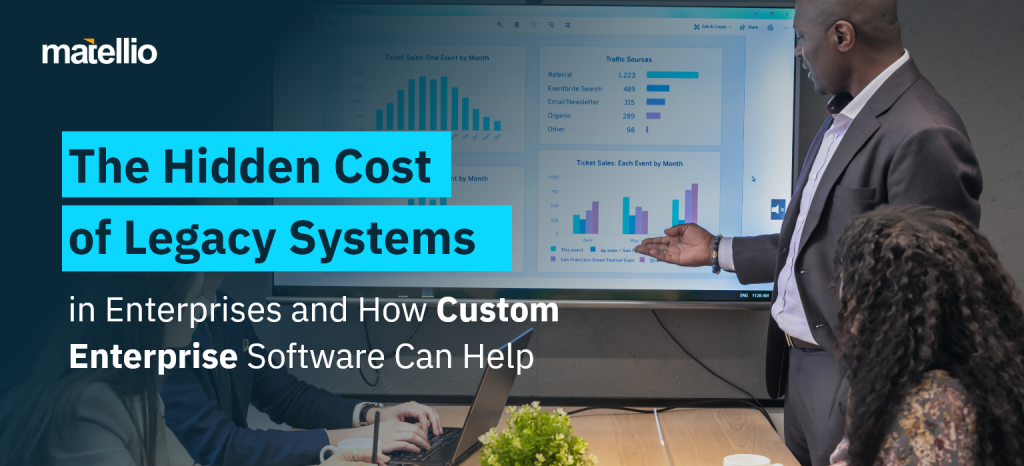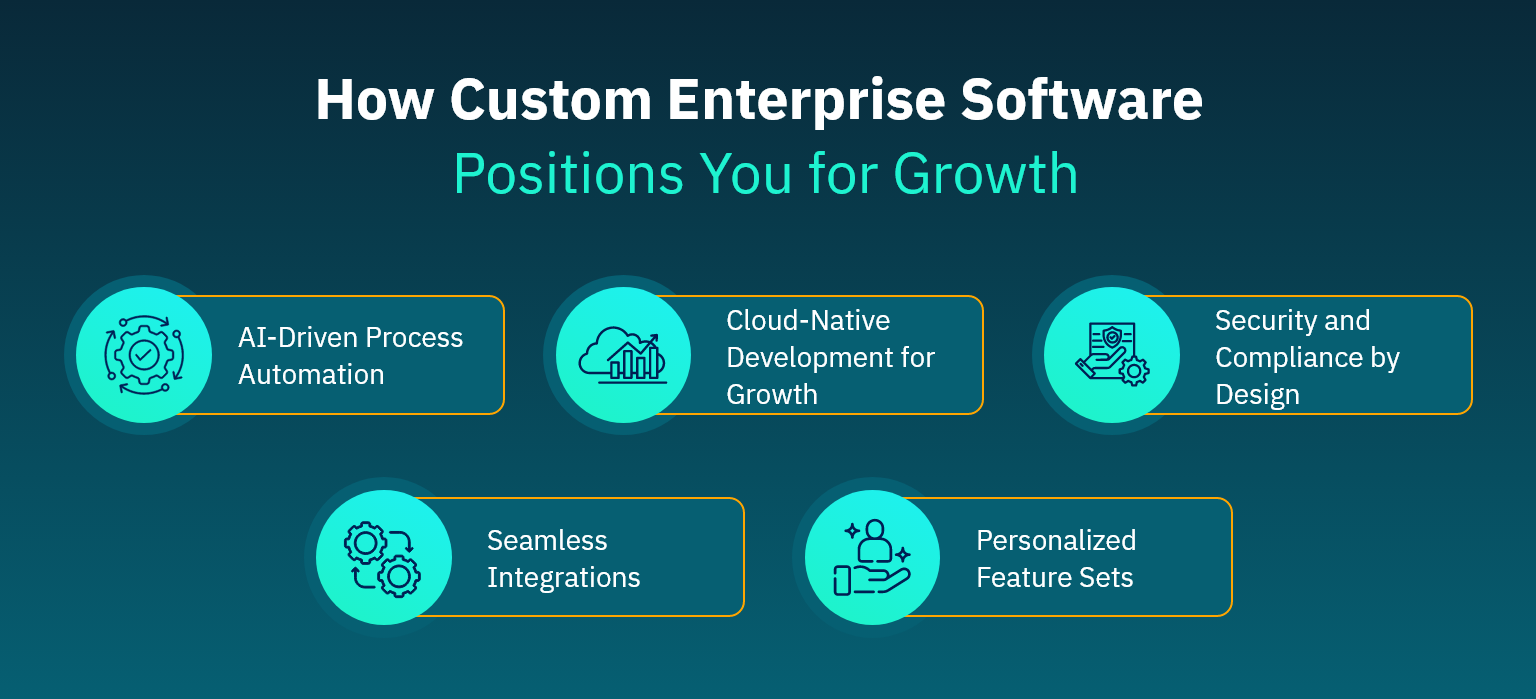
Executive Summary
If you’re finding that releasing new features, adding new technologies, integrating third-party tools, or staying secure is increasingly complex, the real culprit might be your legacy software. Many enterprises stick with outdated systems, assuming they’ll “work for now.” But the hidden operational costs and missed opportunities can silently scale into strategic setbacks.
The technical debt is huge. Businesses spent an average of $2.9 million in 2023 on legacy tech upgrades, while nearly two-thirds reported investing over $2 million just to maintain and patch these aging systems . For most enterprises, that’s capital spent on standing still, not moving forward.
This blog explores how these systems impact growth and performance, and why partnering with a custom enterprise software development company positions you to reclaim efficiency, drive innovation, and align technology with long-term goals. From AI-driven automation to scalable cloud architectures and secure integrations, you’ll discover how modern enterprise software solutions drive tangible outcomes.
I. What Problems Are Legacy Enterprise Systems Creating?
Most enterprises started with software that fit their needs at the time. But as operations scaled and technology evolved, these systems began to hold them back. The consequences are no longer just technical but strategic.
- Stifled Innovation: New features and product enhancements are often delayed for weeks or months, resulting in a slower time-to-market.
- Lack of Integration: Integrating modern tools or platforms becomes a costly, multi-step effort.
- Security Risks: Security updates struggle to keep pace with emerging threats, increasing risk exposure.
- Operational Inefficiencies: Teams resort to manual workarounds because the system no longer fits their workflows.
These issues impact revenue, increase operational overhead, and limit the enterprise’s ability to respond to change. Every delay or workaround adds friction across departments, turning what should be agile execution into reactive firefighting. Over time, these inefficiencies erode productivity and make innovation harder to sustain.
II. The Hidden Costs of Keeping Legacy Systems
On the surface, sticking with legacy systems may seem like a cost-effective approach. But beneath that perception lie expenses that compound over time, and they’re far from minor.
- Every workaround adds to your technical debt, which raises long-term maintenance costs and increases the risk of system failure.
- Project delays pile up as teams navigate outdated architecture, directly impacting time-to-market and product competitiveness.
- Data silos prevent real-time collaboration across teams, resulting in lower productivity and slower decision-making across the organization.
- The global average cost of a data breach hit $4.9 million in 2024 . That’s what unsupported platforms do: expose you to escalating cybersecurity threats and cost you financially.
- Teams lose hundreds of hours each quarter on manual tasks that could be automated, draining resources that could be better spent on innovation.
What feels like short-term savings often results in millions of dollars lost through missed growth, delayed strategy execution, and increased operational drag. The longer you wait, the more it costs to modernize later.
III. How Custom Enterprise Software Positions You for Growth

Agility suffers when scaling enterprises rely on generic software. What you need isn’t just more features but alignment between your technology and long-term business strategy. That’s where custom enterprise software becomes a growth enabler.
Here’s how the right custom enterprise software development company helps future-proof your operations:
- AI-Driven Process Automation: Custom solutions begin by analyzing your core workflows and embedding automation where it matters most. From approvals to reporting, repetitive tasks run in the background, freeing up internal capacity and improving execution speed. It shifts the team’s focus from maintenance to meaningful impact.
- Cloud-Native Development for Growth: Custom cloud-native architectures scale with you. Whether you’re onboarding new customers, entering new markets, or expanding services, you gain the resilience to grow without added infrastructure costs or operational friction.
- Security and Compliance by Design: Instead of layering on security after deployment, compliance standards like HIPAA or GDPR are built into the foundation from the outset. Encryption, access control, and audit logs are integrated from the start, helping you reduce risk, simplify audits, and meet regulatory demands with confidence.
- Seamless Integrations: Custom enterprise software solutions are designed to fit into your broader tech ecosystem, rather than competing with it. Integrations with ERP, analytics tools, payment platforms, and APIs are smoother, removing silos, improving visibility, and enabling faster launches of new initiatives.
- Personalized Feature Sets: Custom platforms deliver the precise workflows, dashboards, and alerts your teams need. Everything is tailored to how your business actually operates, which leads to faster adoption, fewer workarounds, and greater consistency across operations.
IV. Why Choose Strategic Custom Enterprise Development?
When your business model carries unique operational demands, off-the-shelf software rarely keeps up for long. Strategic custom development enables you to turn business goals into technical execution, bridging daily inefficiencies with scalable, long-term solutions.
Rather than bending your workflows to fit generic tools, bespoke enterprise software mirrors how your teams operate, how your customers engage, and where your business is heading.
1. Get More from Software Tailored to Your Business
Standard tools often lack the adaptability that complex or evolving business models need. On the contrary, software tailored to your enterprise allows your systems to scale with you, enabling faster rollouts, stronger collaboration across departments, and greater control over operations. In this model, technology becomes a driver of performance, not just a support layer.
2.Deploy Custom Apps That Scale with Your Enterprise
Custom enterprise applications go beyond basic functionality. They’re tailored software for business designed around your domain logic, compliance standards, and operational priorities. The result: streamlined workflows, reduced manual effort, and improved user experiences that extend across the business.
V. Choosing an Enterprise Software Partner That Aligns with Your Business Strategy
A custom enterprise software development company should do more than build to spec. They should help you translate business goals into scalable systems, built for today and tomorrow. With the right enterprise tech partner, software stops being a cost center and becomes a strategic asset that accelerates delivery, strengthens resilience, and fuels growth.
The right partner will:
- Map business goals and workflow bottlenecks with precision
- Build a tech stack for long-term adaptability and scale
- Plan implementation in phases that preserve uptime and team momentum
- Stay engaged post-launch to evolve features, handle integration changes, and optimize over time
- Bake security, compliance, and scalability into every stage of development, not as afterthoughts
VI. Case Study Spotlight: How Phoenix Replaced Legacy Systems with Scalable Enterprise Software
One global enterprise made the shift from fragmented, manual operations to a unified, scalable system, proving how strategic custom development can solve long-standing inefficiencies and support sustainable growth.
The Challenge
A leading global enterprise, faced significant challenges due to its legacy systems. It aimed to replace fragmented procure-to-pay systems with a unified platform for finance, payroll, and HR. Employees needed a simple timesheet tool, while managers required better visibility into time and expense workflows. Without system-wide integration, ERP and payroll connections became bottlenecks, limiting scalability and operational efficiency. To move forward, Phoenix needed a solution that automated processes, ensured compliance, and scaled globally.
The Solution
The client partnered with us to build a next-gen time and expense management platform. The solution featured:
- An intuitive timesheet and project tracking system for ease of use across teams
- AI-powered invoicing and automated payroll workflows to eliminate paperwork
- Integration of over 1,200 ERP, HR, and accounting systems for cohesive data access
- Customizable dashboards for real-time visibility
- Role-based access and SOC compliance from day one
The Impact
With the custom time and expense management platform, the global firm was able to reduce operational complexity and automate 80% of payroll tasks. With 100% SOC compliance, the custom platform enhanced user adoption, giving them a global edge in terms of scalability.
VII. 5 Triggers That Signal It’s Time for Tailored Enterprise Software
Recognizing when your current systems are holding you back is critical to staying competitive. Identifying these triggers early allows you to act decisively before inefficiencies begin to compound and limit enterprise momentum.
Here are five clear indicators that it’s time to consider custom enterprise software solutions:
- Teams rely on workarounds or duplicate entry to complete daily tasks.
- Key processes remain manual despite multiple digital tools in place.
- Compliance or security gaps are flagged more frequently by audits or IT.
- Growth initiatives are delayed due to system limitations or a lack of flexibility.
- Senior leadership spends more time troubleshooting tools than driving transformation.
VIII. How to Select the Best Enterprise Tech Partner
A strategic partner brings clarity, speed, and alignment, helping you turn technology into a consistent advantage.
1. Look for Proven Experience in Your Industry and Scale
A strong partner understands the nuances of your sector and has delivered solutions at enterprise complexity and volume. This ensures faster onboarding, fewer assumptions, and better alignment from day one.
2. Prioritize Technical Breadth Across Cloud, Security, and Integrations
It’s not enough to build software that works today; it must also be adaptable for the future. Your partner should have a track record of executing seamless cloud migrations, managing secure architectures, and integrating with ERPs, CRMs, and other third-party systems, without creating future bottlenecks.
3. Demand Transparency and Measurable Outcomes
From planning through deployment, you should expect clear timelines, defined milestones, and performance metrics tied to your business goals. A reliable partner shows their work, communicates proactively, and makes data-backed decisions.
4. Choose a Partner Who Collaborates, Not Just Delivers
Transactional vendors stop at handoff. A strategic partner co-creates solutions with your leadership and product teams, adapting to your internal processes, user feedback, and evolving priorities as the engagement matures.
5. Ensure Post-Launch Support and Future-Ready Planning Are Built In
Enterprise systems evolve. Your partner should provide structured support, scalable architecture, and a roadmap that allows your technology to grow with your business without needing a rebuild every two years.
IX. Move Beyond Legacy Limits with Future-Ready Systems
Legacy systems may have supported growth in the past, but today’s business environment demands flexibility, speed, and continuous innovation. By working with a custom enterprise software partner, you can eliminate outdated constraints, increase agility across teams, and scale your operations with confidence.
If your goal is to align technology with long-term business performance, this is the moment to make that shift. Matellio helps enterprises replace legacy infrastructure with modern, purpose-built platforms that drive efficiency, support innovation, and adapt as your strategy evolves.
Ready to modernize your systems?
See how the right enterprise tech partner can accelerate your growth.
Key Takeaways
- Legacy systems quietly create costs, inefficiencies, and security concerns.
What appears to be a cost-saving decision often masks hidden expenses, including rising maintenance overhead, delayed feature releases, and increased risk exposure. Over time, these inefficiencies limit your ability to scale, respond to changes, and innovate.
- Custom enterprise software solutions align with your strategy and scale with your business.
Tailored platforms reflect how your teams work, not how a vendor assumes they should. This alignment ensures technology supports your goals, not the other way around, as your business evolves.
- Tailored automation, cloud-native design, and secure architecture build long-term value.
Purpose-built systems reduce manual workloads, scale effortlessly with demand, and embed compliance from the start. These foundations help enterprises stay agile and resilient in rapidly changing environments.
- A trusted enterprise tech partner brings industry knowledge and continuous innovation.
Beyond development, the right partner serves as a strategic guide to help you navigate complexity, adopt emerging technologies, and evolve systems as your needs grow.
- Modern systems reduce complexity and accelerate digital transformation.
By eliminating silos, enabling integrations, and simplifying workflows, custom enterprise platforms remove friction across departments and create the conditions for sustained innovation.
If your current tools no longer support growth, compliance, or efficiency, a custom solution offers flexibility and control that generic software can’t match. When workarounds become routine and innovation is limited by platform constraints, it’s time to invest in a tailored approach that aligns directly with your business goals.
Look for partners with experience in your industry, a strong portfolio of enterprise-grade solutions, and proven expertise in cloud, security, and integrations. Check for transparent processes, long-term client relationships, and a collaborative approach to ensure they can support both current needs and future scalability.
Begin by evaluating your current pain points, business goals, and user workflows. Define what success looks like across teams, and align on measurable outcomes. It’s also important to involve key stakeholders early, assess integration needs, and plan for long-term scalability and compliance.
Beyond project handoff, you’ll receive continuous support for upgrades, integrations, and evolving business needs. The best partners offer proactive monitoring, roadmap planning, and flexible scaling so that your system stays aligned with future growth.
Yes, your software can include intelligent automation, predictive analytics, and data-driven dashboards to support smarter decision-making. These capabilities help uncover insights, optimize operations, and improve forecasting across business units.


